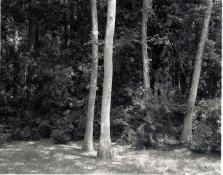Kind of an odd question-- and possibly an impossible one at that.
I'm a novice at B&W film development-- I recently decided to enter the world of large format photography (I admit, the research is something to do while not going anywhere along with the rest of the world), so I kitted myself out with a camera, some lenses, various bits and pieces related thereunto, some film, and some chemicals (and related paraphernalia).
Then I took 4 exposures, realized two of them were moderately overexposed, and put them into the "revisit later" pile.
The other two exposures, however, came out fairly well-- I think. And here's the problem: I lack the knowledge to be able to grade my own work. I'm reasonably happy with the exposure and the focus, but the question is, could I have done better developing them?
So, technical details: Arista EDU 400 (Fomapan 400), developed with Ilfosol 3 @ 68F, 8:30 minutes, 30 seconds agitation first minute, 4 agitations each minute after, rinsed (I was warned about the fomapan anti-halation green menace) once, Ilfostop for 15 seconds, Ilford Rapid Fixer for 3:00 minutes, rinsed with the Ilford 5/10/20 method for rotary tanks. Tank was actually the Stearman SP-445.
And since all this would be pointless without an image:

Scanned with Epson v800 / Silverfast SE.
Given all that information, and understanding that there are N+ a whole lot of variables here, is there anything development-wise I could / should have done to improve the final image?
I'm a novice at B&W film development-- I recently decided to enter the world of large format photography (I admit, the research is something to do while not going anywhere along with the rest of the world), so I kitted myself out with a camera, some lenses, various bits and pieces related thereunto, some film, and some chemicals (and related paraphernalia).
Then I took 4 exposures, realized two of them were moderately overexposed, and put them into the "revisit later" pile.
The other two exposures, however, came out fairly well-- I think. And here's the problem: I lack the knowledge to be able to grade my own work. I'm reasonably happy with the exposure and the focus, but the question is, could I have done better developing them?
So, technical details: Arista EDU 400 (Fomapan 400), developed with Ilfosol 3 @ 68F, 8:30 minutes, 30 seconds agitation first minute, 4 agitations each minute after, rinsed (I was warned about the fomapan anti-halation green menace) once, Ilfostop for 15 seconds, Ilford Rapid Fixer for 3:00 minutes, rinsed with the Ilford 5/10/20 method for rotary tanks. Tank was actually the Stearman SP-445.
And since all this would be pointless without an image:

Scanned with Epson v800 / Silverfast SE.
Given all that information, and understanding that there are N+ a whole lot of variables here, is there anything development-wise I could / should have done to improve the final image?




